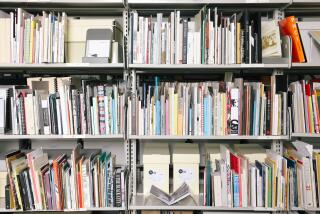Eggs-quisite Exhibit
- Share via
Mention Faberge and eggs come to mind. Not the edible kind, but tiny, exquisitely jeweled pieces of art, throwbacks to Russia’s opulent past and the Romanov dynasty.
Two of the priceless eggs are among 28 dazzling Faberge creations--clocks, cigarette cases, bookmarks, picture frames--in an exhibit opening Saturday at the Ronald Reagan Presidential Library near Simi Valley.
So alluring is the Faberge name that museum officials have beefed up security around the priceless objects, on loan from the Forbes Magazine Collection.
“This is the most special thing we’ve ever done in terms of art,” said Lynda Schuler, the museum’s director of public affairs. “It’s more than art--it’s history.”
The story of these treasures parallels Russia’s tumultuous years during the end of the 19th century and the beginning of the 20th. The Faberge family had fled France for Russia two centuries earlier, building a jewelry business known for its creativity and craftsmanship. But it was the family’s close ties to the imperial Russian clan that brought world acclaim.
In 1885, Czar Alexander III commissioned the House of Faberge to create a jeweled Easter egg for his wife, something that became an annual tradition that his son, Nicholas II, carried on after his father’s death.
These eggs were so intricately crafted that they sometimes took more than a year to complete. Not only were they exquisite, but they were engineering feats as well, because most held “surprises”--a tiny portrait or jewelry--inside.
The Faberge reputation spread, and the company led by Peter Carl Faberge was soon getting orders from royalty and other affluent customers around the world. But the Russian Revolution in 1917 spelled the end for the Romanovs and their excesses. It was the end for the House of Faberge too, and the family fled Russia.
Of the two jeweled eggs in the exhibit at the Reagan library, one is believed to have been commissioned by Czar Nicholas’ wife, Alexandra, for a close friend. The egg, decorated with gold laurel swags, rests on four golden hooves. The surprise inside is a miniature portrait of the czarina.
But the centerpiece of the exhibit is a frosty-looking egg created for Dr. Emmanuel Nobel, a wealthy Swedish industrialist and nephew of Alfred Nobel, the inventor of dynamite and originator of the Nobel Prize. The egg, inspired by the frost-covered windowpanes of the Faberge studio, opens to reveal a diamond-studded watch pendant. A recent purchase by the Forbes family, the Nobel egg has never been viewed by the American public.
The exhibit, which runs through Jan. 10, will be the first showing on the West Coast for many of the Faberge items.
And how did the Reagan library luck into getting this exhibit? It wasn’t really luck. Steve Forbes, son of the famous publisher-collector Malcolm Forbes and one-time presidential hopeful, is on the library’s board of trustees.
“Steve helps us with a lot of things,” Schuler said.
*
“Regal Splendor: Masterpieces From the House of Faberge” opens Saturday at the Ronald Reagan Presidential Library, 40 Presidential Drive, near Simi Valley. For information, call (805) 522-8444.
*
Though not as dazzling, the new exhibit at the Santa Paula Union Oil Museum will stir childhood memories for those who recall the days before television.
For kids, those were the days of marbles, toy soldiers, paper dolls, Lincoln Logs, Ouija boards and those clunky strap-on roller skates with the key.
The Santa Paula Historical Society has rounded up a slew of these items for a special exhibit running through January. Scouring local attics, garages and personal collections, they found everything from a turn-of-the-century copy of L. Frank Baum’s “The Road to Oz” to a 1941 game of Monopoly.
Mike Shore’s contribution was a Milton Bradley marine-themed collection--wooden battleship, destroyer, lighthouse, ocean liner--made during World War II.
“There was a scarcity of metal then, so things were made out of wood,” said Shore, who helped compile the exhibit.
Among the other treasures is a pink pedal car belonging to Santa Paula Police Sgt. Carlos Juarez, who collects and restores them. On the wall are cases of lead toy soldiers from the collection of Richard Ferrier, who teaches at Thomas Aquinas College.
Perhaps the most intriguing of all is a family of clown dolls sewn by Irene May Whitcher.
She made scads of them, distributing them locally to children at Christmastime. Two years before she died in 1979 at the age of 89, she wrote a children’s book about a clown family that left the circus life and settled down in a small farming community.
For information, call the museum at (805) 933-0076.
More to Read
Sign up for The Wild
We’ll help you find the best places to hike, bike and run, as well as the perfect silent spots for meditation and yoga.
You may occasionally receive promotional content from the Los Angeles Times.






